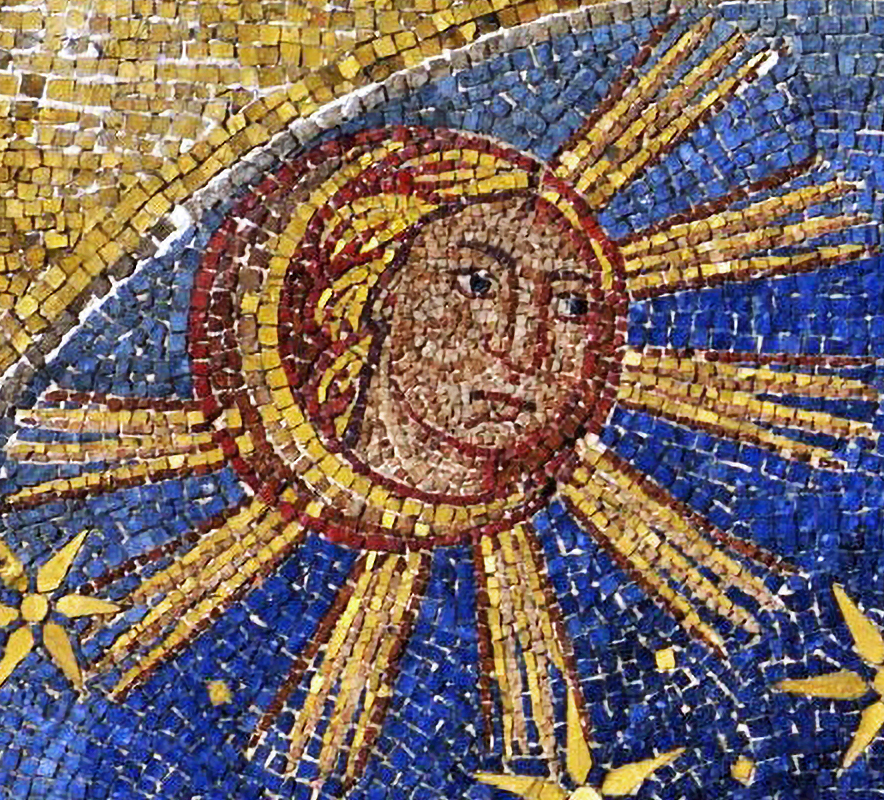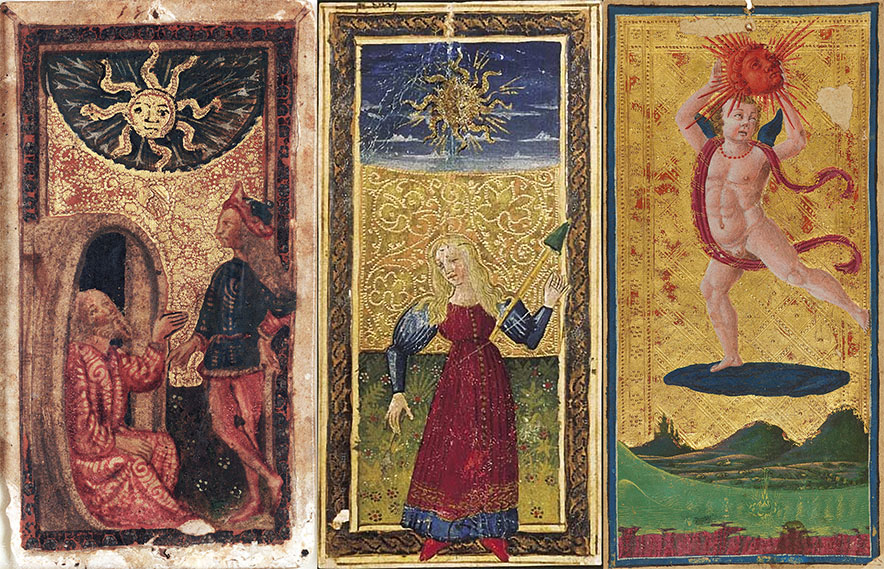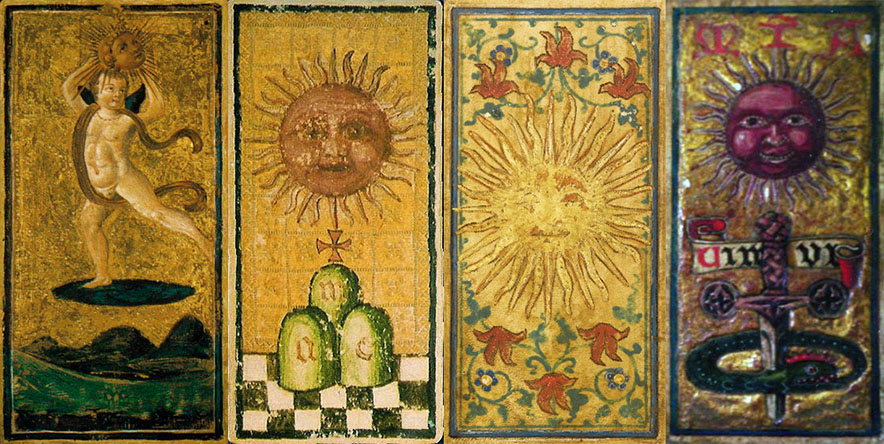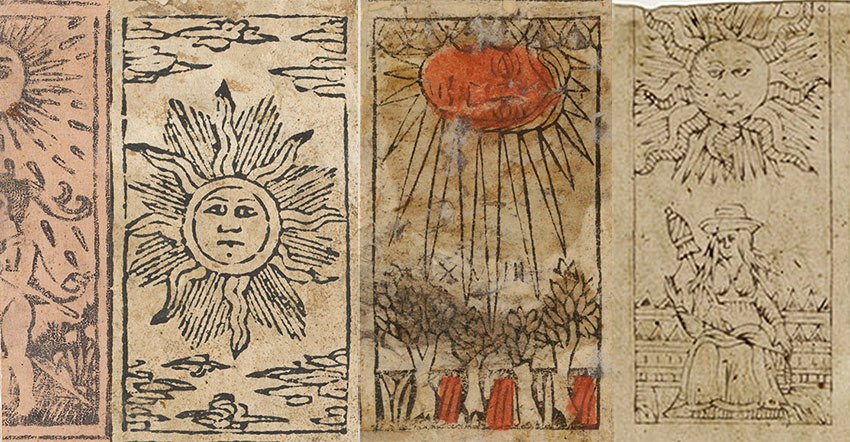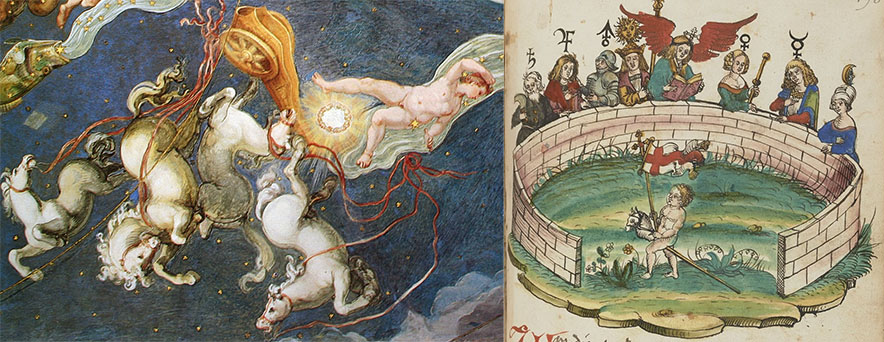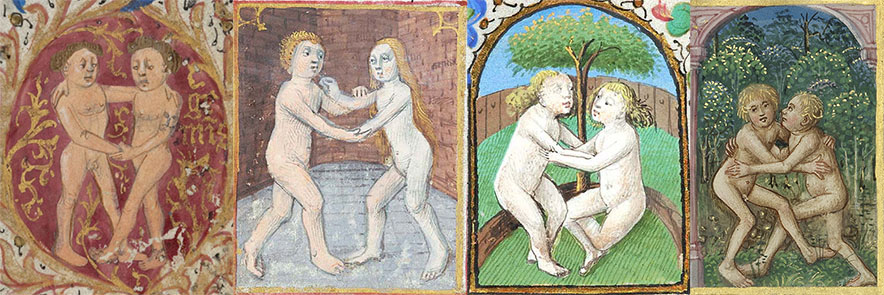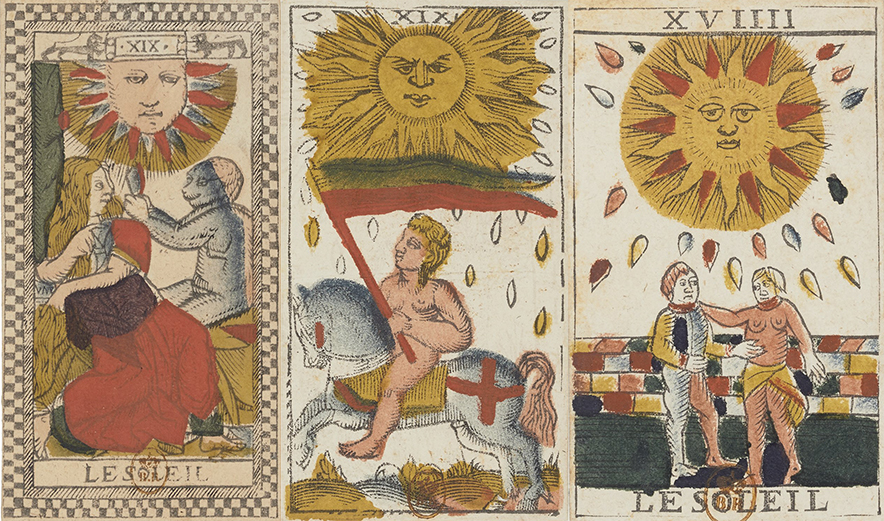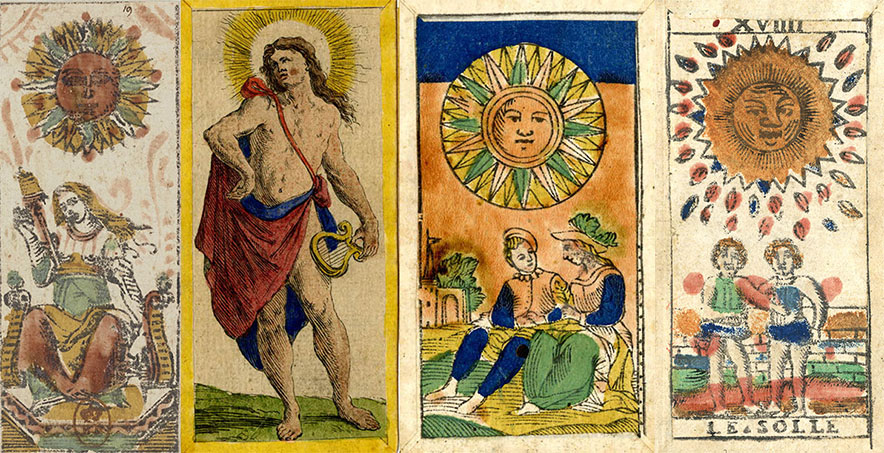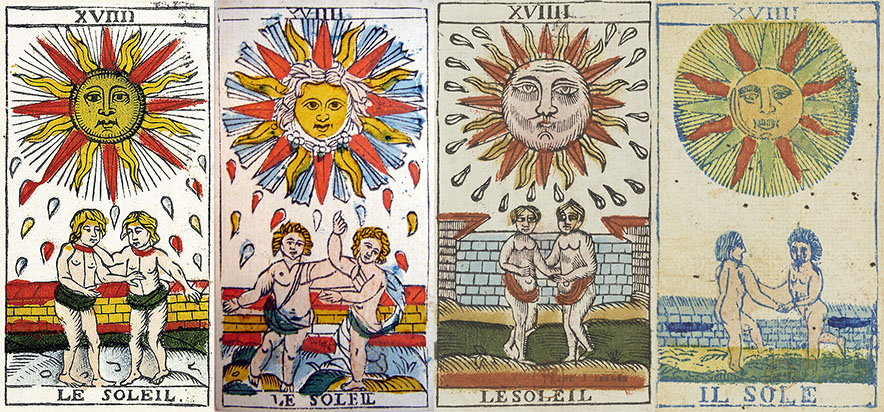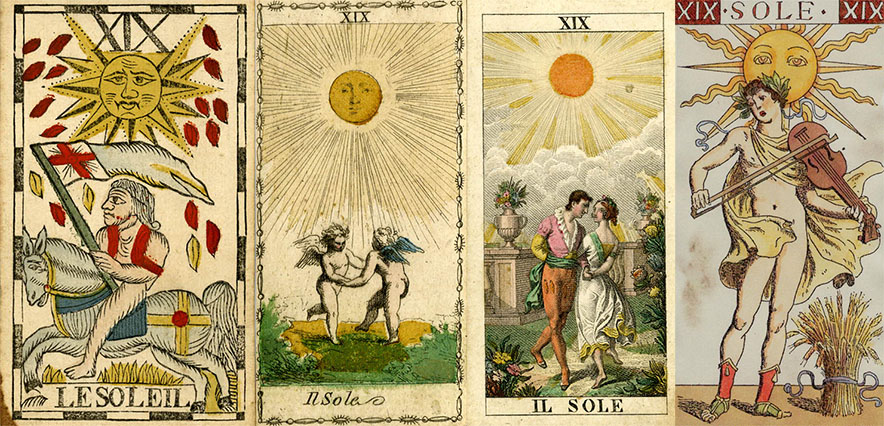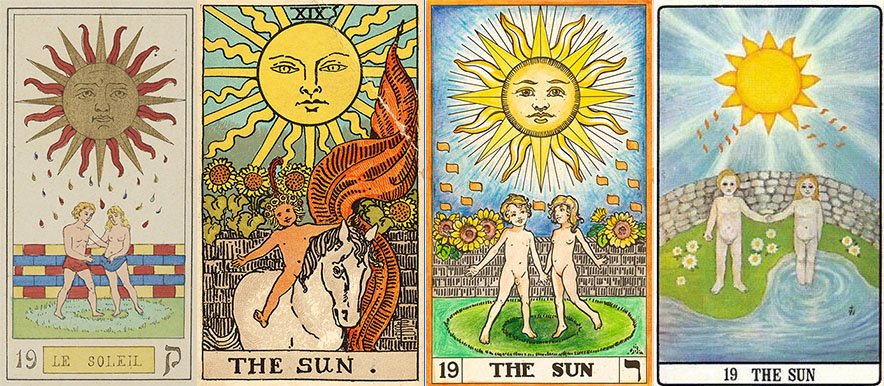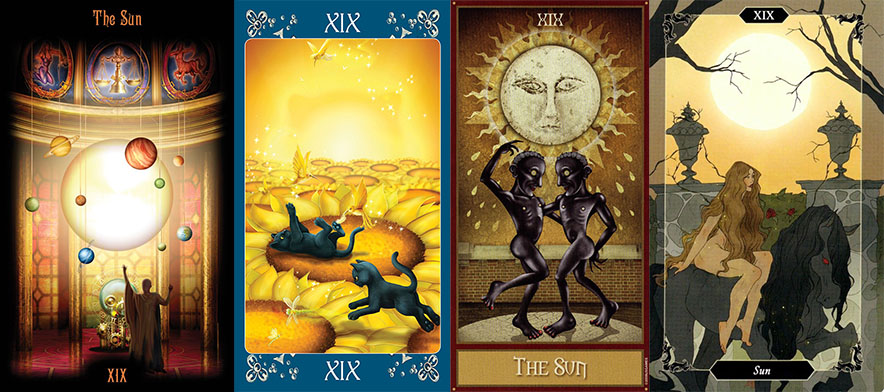THE TAROT WHEEL
EL SOLE - THE SUN
Like on the previous page, we start this page with a detail of a beautiful 13th Century mosaic representing the Creation of the world, that can be found in the San-Marco basilica in Venice. Here we see the Sun in all its splendor as the most important object in the sky. The sun delivers us light and warmth and as such most ancient civilizations considered the sun as one of the most important Gods in Heaven. And also in the Tarot it occupies a very important place, just below the last judgement and the universe itself. Let us first have a look how the Sun was represented in the oldest hand painted and printed Tarot decks. Let us start with the three best known decks.
The first card is from a deck commissioned by Duke Ercole I of Este at the occasion of his marriage in July 1473 with princess Eleonor, daughter of King Ferdinand I of Naples. The second card is from the so-called Charles VI deck, that has also probably been commissioned by the court of Ferrara. Because the deck does not show any heraldic symbols, it is very difficult to date and to attribute. The third card is from the Milanese Visconti Sforza deck created by Bonifacio Bembo. However, the Sun card (as well as 5 other cards) is nowadays attributed to the Ferrarese artist Antonio Cicognara and believed to have been added to the Visconti Sforza deck in the last quarter of the 15th Century, some time after the structure of the trumps had evolved from 14 to 22 cards.
On the first card is represented the famous encounter between Alexander the Great and the philosopher Diogenes the Cynic. The young king asked Diogenes if he could do something for him. "Yes" answered Diogenes, "please step aside, you're blocking the sunlight". On the second card we see Clotho, one of the Moirai or Fates in Greek mythology. The three Fates had to assure that any human being lived his life according to his destiny. Clotho was the spinster of the three, who was spinning the thread of life. The third card represents a winged putto standing on a dark cloud and holding the sun high in the sky. Like the Moon, the Sun was very often personified and represented with a face.
Apart of these famous Sun cards, several other cards survived.
The next four cards are lesser known cards, dated to the end of the 15th Century. The first card from the left is part of a private collection that belonged to the Milanese collector Amedeo Cochi. The card was published in an Art journal in November 1986. It is a copy of the Visconti Sforza Sun and dates probably from the end of the 15th Century. The second card is the Goldschmidt Sun card, that belongs to a series of 9 cards that is conserved in the Deutsches Spielkarten Museum in Leinbergen. It is a very atypical Sun card, and the three hills with a cross on the top make us think of Golgotha. The letters AMC (MAC?) could not be explained by the experts. Maybe it refers to the Acta Marthyrum Christianum. The Acta Martyrum is the oldest Latin text that describes the trials of the first Christian martyrs. The third card is very similar to the Rosenwald Sun, shown her below. It appeared on an auction by Christies and has been identified as a 15th Century Trionfi card by an Italian expert (Christina Quattrini). The last card belongs to the Guildhall card in London. Experts don't agree if this card represents the Sun or the Ace of Swords. Also here, on all cards, the sun has been portrayed with a human face. This same tradition continues on the printed cards from the same epoch, which are shown here below:
All four cards date from the end of the 15th or the beginning of the 16th Century. Precise dating of the cards is impossible. All cards come from uncut sheets found in the bindings of old books. From left to right we have the Cary Yale sheet, the Rosenwald sheet, the Budapest sheet and the Rothschild sheet. On the Cary sheet, we see below the sun a naked boy, several interpretations are possible. The illustration could represent a boy riding on a wooden stick with a horse's head, or it could even be two children playing together. More about this representation here below in the Art section. The Rosenwald card has as only symbol the Sun, much like the Christie's card presented here above. As on many other old images, the Sun is represented with straight rays, representing light, and curvy rays, representing heat. On the third card, we see a red-headed sun sending his energy of life to trees and fields of crops. The last card is almost identical to the Charles VI card, with Clotho spinning the thread of life. As for the Moon card, we remark a great diversity under the cards, the representation of the Sun has clearly not yet standardized. But how the sun was represented in medieval and renaissance Art?
In the oldest expressions of art, the Sun was associated with the Gods and with mythology. Every ancient people had their Sun God, The Sumerians called him Utu, the Babylonians Shamash, the Egyptians Ra, the Greek Helios and later Apollo. The Romans adopted Apollo as God of the Sun, especial in poetry, but they also developed their own God, Sol (or Sol Invictus). Sol is the Latin word for sun and as such just a translation of the Greek word helios). Here below some representations of these Gods:
On the first image we see the Egyptian Sun God Ra, the mightiest of the Gods, also God of the Creation. He was often represented having the head of a hawk with a sun disk on his head. This painting has been found on the tomb of Queen Nefertari, first wive of the great Pharaoh Ramses II. She died approximately 1249 BC. On the second image, we see the Babylonian Sun God Shamash. His most important attribute was a sun disk, represented with four straight rays and four groups of several wavy rays, the straight waves representing light, and the wavy rays representing heat. The same representation of the sun symbolized with straight and wavy rays became later a family symbol for the Milanese Visconti Dukes, and is until present very often used on Tarot cards. The relief has been dated to the reign of the Babylonian King Nabu-apla-iddina, ca. 888 – 855 BC. The last image is a detail of a Greek vase, dated to approximately 430 BC, representing the Sun God Helios on his Sun Chariot, pulled by 4 winged white horses. Under the horses we see a boy falling, representing Phaeton, son of Helios and a mortal woman. One day, Phaeton asked his father if he could drive the Sun Chariot. Helios agreed very reluctantly. To make a long story short, Phaeton was not capable to restrain the horses, he burned a part of the Earth (this is according to the story how the great Sahara desert was created, and why people in Africa are black) and Zeus was forced to intervene, by striking Phaethon with a lightning bolt. The boy felt with a trail of fire behind him like a falling comet to Earth. There are many versions of this story. In some of them, Helios was so sad after his son died that he refused to mount the Sun Chariot again. As a consequence, Zeus was obliged to nominate Apollo as the new Sun God. The same story can be found back on the so-called Tarot of Mantegna and was very popular in Renaissance Art.
The next three images are very similar and represent three different mosaic floors. The first one dates from the second century BC and is located in Sparta in Greece. It represents the God Helios. The second image was found in Carthage (nowadays Tunisia) and dates from the second century AD. The third image represents the Roman God Sol Invictus. On the 25th December 274, the Roman emperor Aurelian made the Sun God an official religion alongside the traditional Roman cults. Since that date, the Romans celebrated on the 25th of December the birth of Sol Invictus. The Christians converted this date in Christmas, to celebrate the birth of Jesus Christ. This representation of the Sun, as the head of the Sun God surrounded by a halo and sun rays, became the most widely used representation of the Sun in Western Europe. On all early Tarot cards, as shown here above, the Sun is represented similarly, with a face on the Sun disk.
The following images range from the end of the 14th Century to the end of the 15th Century. The first image is from the Visconti book of hours, made for the first Duke of Milan, Gian Galeazzo Visconti. Many things are told about Gian Galeazzo, but he was anything except modest. Here he has his own face painted on the Sun disk. The second image is a detail of the Sun card of the 1470 Tarot of Mantegna. Here we see a winged woman riding the Sun lane and holding the sun in her hands. Here also we see a boy falling, representing the story of Phaeton. The last image is from a Florentine book of hours made at the very end of the 15th Century. Here we see the Sun disk in its traditional form, with straight and wavy rays. On the Sun lane, we see the Zodiac sign of Gemini. This image brings us to the later Tarot of Marseille that uses Gemini to illustrate the Sun card. We us continue with two Sun related 15th Century images before we go back to the Tarot cards.
On the left, we see the fall of Phaeton, son of Helios. This image can be seen in the room of Maps in the Palazzo Farnese at Caprarola and painted between 1573 and 1575. The painter links the fall of Phaeton to the demise of Atlantis. The sun is represented as a very bright disk, and for once, without a face on it. The second image is from a German treatise on astrology. It has been created by a certain Johannes Hartlieb, who lived according to the BNF, where the manuscript is conserved, from 1400 to 1468. On the image, we see the Sun child riding in a garden on a toy horse and carrying the same banner with which the resurrected Christ is often depicted, which stands for victory over death. Behind the wall of the garden, we see the archangel Michael surrounded by the 7 known celestial bodies. The Sun is in the middle next to the archangel Michael. The partial image of the Cary sheet here above might depict the same Sun child. The image reappears on the 17th Century Tarot of Jaques Vievil and on the 18th Century Belgian Tarot. And also the Rider Waite Smith Tarot might have been inspired by the same source, although here, the white banner with the red cross has been pushed to the next card, representing Judgement.
Like on the two other Tarot cards of celestial bodies (Star and Moon), we will show here some images of a zodiac sign possibly related to the Sun card, in this case the sign Gemini that could be at the base of the illustration of the Sun card of the Tarot of Marseille
Here above 4 representations of the Zodiac sign Gemini. We see two boys, or a boy and a girl, embracing each other or wrestling together. They are in a protective environment or just outside. The first three images are from 15th Century French books of hours, the last one is from a 16th Century German prayer book. No sun is visible, but the images are shown because of the resemblance with the Tarot of Marseille.
Our conclusion of the art section and the 15th Century Tarot cards is simple. There is a standard representation of the Sun (a yellow disk with a face on it surrounded by straight and wavy sun rays), but there is no standard representation of the Sun Card. Some card makers, like the one who created the Rosenwald sheet, illustrated the Sun and nothing else. Other card makers tell a story, in line with their interpretation of the signification of the Sun card. This habit of telling their own story goes well into the 17th Century, before some patterns become more or less fixed. In Italy, that has a much longer history of Tarot cards, this standardization of patterns started earlier than in France. Here below some examples of French and Italian cards from the 17th Century. We start with the French cards.
Three new images, not used on any Tarot Sun card before. All three cards are made in Paris in the 17th Century. For the first time, the title is written on the card. Numbering the cards was already done in Lyon in the 16th Century, but no Sun cards from this epoch survive. The card is from the anonymous Tarot of Paris and is dated to approximately 1625. On the scene, we see a monkey holding a mirror in front of a young lady, who seems not to be pleased with what she sees. On the second image, we see the Sun-child riding a real horse. The red cross symbolizing the victory over death cannot be seen on the banner, but is painted on the horse. The third image represents a Sun card from the oldest Tarot of Marseille we know, the best known standard pattern in Tarot. We see two children, a boy and a girl, within the walls of a protected garden, just as on the Gemini illustrations. As we shall see here below, ancient Italian Tarot cards do or do not follow a standard pattern. Here below some examples.
All the above cards have been printed in Bologna. This emphasizes that in the 17th Century, Bologna had become the most important center of card making in Italy. From left to right we have the anonymous Tarocchino Fine Dalla Torre dating from the early seventeenth Century, the 1668 Tarocchino made by Giuseppe Mitelli in order of the rich Bentevoglio family, an anonymous Minchiate Sun card dating from the early 18th Century and a Tarocco Sun card made by Francesco Berti in the second half of the 17th Century.
The first card is almost identical to the Sun card of the Rothschild sheet (that belongs probably to an early Tarocchino deck) and uses the same pattern as used on the Charles VI deck. Until today, Tarocchini decks are produced using this same pattern, making it the oldest standardization in Tarot patterns. The second image has rarely been used before, it is a classical pose of the Sun God (and God of music) Apollo. The third image is from a Bolognese Minchiate deck. This pattern has been developed in Florence. A card made in Bologna has been shown because of the much better quality of the Bolognese cards. The Minchiate pattern was widely used as a standard pattern in the 18th Century, to die out as a game in the 19th Century. The last image is very similar to the Tarot de Marseille pattern. Because the oldest Tarocchi games made in Italy use French titles, it is believed that this pattern was Introduced in Italy coming from France. However, there are some Tarot experts who believe that this pattern has his origins in the Milan region.
In France and most surrounding countries, the Tarot de Marseille became the standard pattern during the 18th Century and well into the 19th Century, with some regional adopted variations. Here below some examples of the Tarot of Marseille Sun card and its local variations from this epoch:
From left to right, the 1709 Pierre Madenie Sun card printed in Dijon in France, the 1751 Claude Burdel Sun card, printed in Fribourg in Switzerland, the Jacob Jerger Sun card, printed between 1920 and 1845 in Besançon and the 1865 Solesio Sun Card, printed in Genova in Italy. The Pierre Madenie card is considered the finest example of early Tarot of Marseille cards. The Swiss card maker Claude Burdel made a much happier version of the Sun card, the Jerger card is typical for the Besançon style decks and the Solesio card belongs to the Piemontese variant of the Tarot of Marseille cards.
During the 18th Century, printing techniques improved a lot. We encounter now much more sophisticated versions of existing patterns and also new variants of the Tarot decks.
From left to right we see the 1775 Belgian Tarot of Vandenborre, the 1810 Milanese Tarot of Lombardy, the 1835 Milanese Della Rocca Tarot and the 1893 Vachetta Tarot. The Belgian Tarot is a revival of the Vievil Tarot. Here we see the Sun-child riding a real horse while carrying the red cross banner, signifying a victory over death. The Tarot of Lombardy has many influences. The card makes us think of the Tarot of Marseille, with two naked cupids dancing together in the bright Sun. The Della Rocca Tarot revisits and modernizes the Tarot of Marseille, transforming the Gemini children in a couple of lovers. Vachetta goes back to the classic times, choosing the Sun God (and God of music) Apollo as the main subject.
In the 19th Century, the Tarot was embraced by French occultists, and they adapted the Tarot of Marseille for their own occult practices. One of these occultists, the France based Swiss Oswald Wirth created in 1888 his own deck, based on the Tarot of Marseille and largely influenced by the ideas of Eliphas Levi. Eliphas Levi had assigned a letter of the Hebrew alphabet to each of the 22 trump cards. The first card at the left is the Sun card, designed by Oswald Wirth. In the early 20th Century, English occultists belonging to the Hermetic Order of the Golden Dawn, became interested in the Tarot. In 1909 Arthur E. Waite published a Tarot deck, loosely based on the teachings of the Golden Dawn. Main reason for this was that the teachings of the Golden Dawn were secret. The second card here above is the Sun card created by Pamela Colman Smith following the instructions of Waite. Some years later, the American Paul Foster Case published the So-called B.O.T.A. deck, that follows the Waite Smith deck while correcting some "errors" of Waite. The third card here above belongs to this deck. It has been colorized, the B.O.T.A. deck is until today only available in black and white. The B.O.T.A. deck is the first publication that shows the Golden Dawn association between the Tarot trumps and the Hebrew alphabet, which is different from the way the French occultists associated them. The Sun card is much closer to the Tarot of Marseille tradition (and to Oswald Wirth's interpretation) than the Waite Smith Tarot, with two naked children playing within the protective limits of a garden. However, it is only in 1977 that Israel Regardie publishes a Tarot deck that is following exactly the teachings of the Golden Dawn. Its Sun card is the last card shown here above.
In the 20th Century, the Tarot popularized and everyone became able to produce his own Tarot deck. Standard patterns were abandoned and many thematic Tarot decks were created. Here below some examples of this wave of creativity that continues up until today.
From left to right, we have the 2009 Legacy Divine Tarot created by Ciro Marchetti, the 2013 Black Cats Tarot by Maria Kuara, the 2015 Deviant Moon Tarot by Pätrick Valenza and the 2020 Dark Wood Tarot by Sasha Graham. All these cards give a very personal vision of the artists on the Tarot, we are here very far from standard patterns or classical influences.
The Sun brings us energy and light, he is at the basis of all life on Earth. So it cannot surprise anyone that the Sun has been worshiped by many people as their main God, the creator of the Universe. And also in the Tarot the Sun is the source of all life, a positive card symbolizing success and optimism. Over time, the Sun stayed the same, only its story was told in different ways. Today many new Tarot decks appear, some based on traditional patterns and many adding new stories to the card of the Sun. With these words I will end our journey through time accompanied by the Sun.
